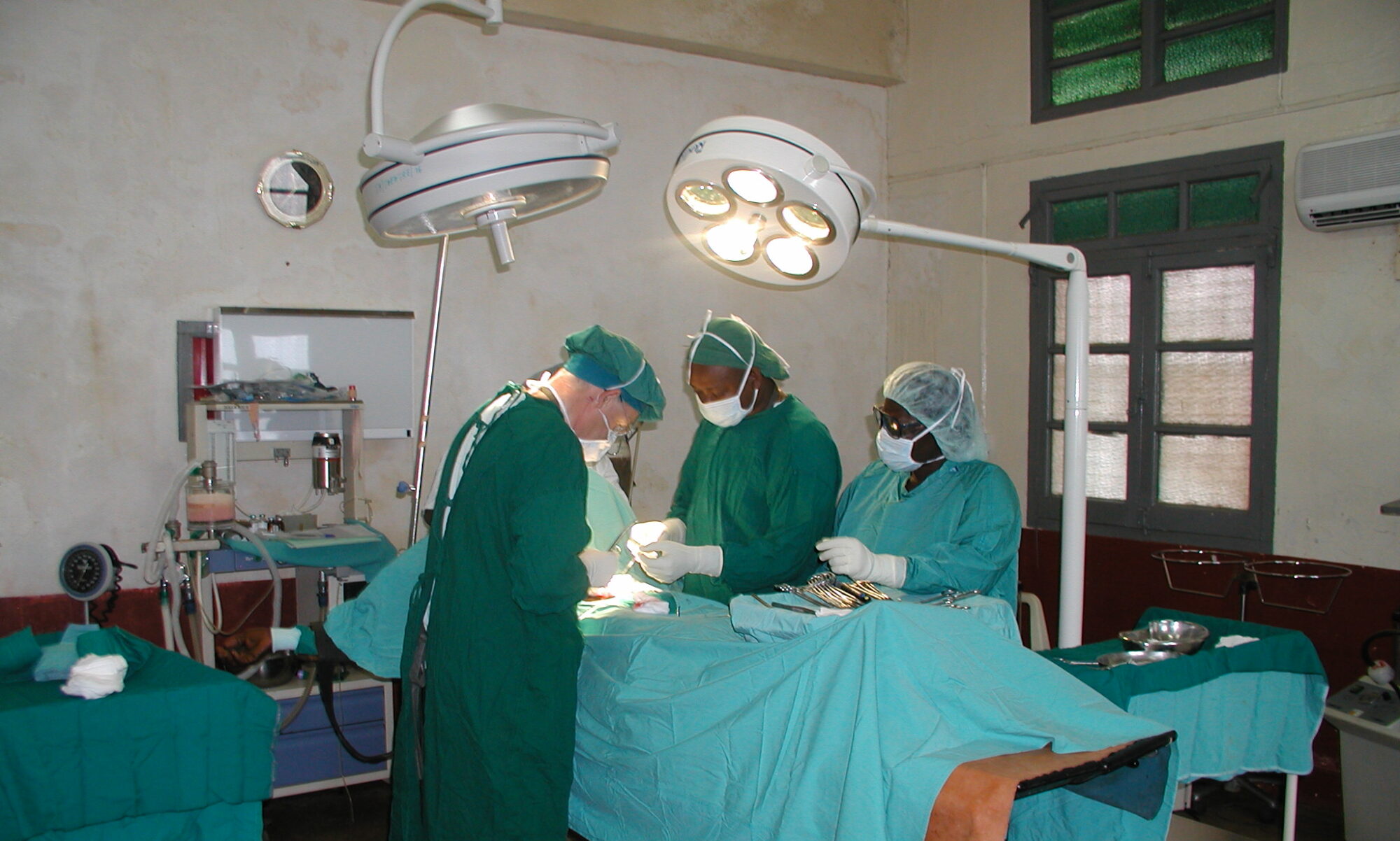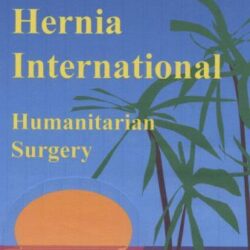Korogwe Hospital, Tanzania – May 2017
The team and the mission
In May 2017 Hernia International arranged for a team of surgeons and anaesthetists to be deployed to Korogwe Hospital in Tanzania. Mr Alex Stanek, a consultant surgeon from Northern Ireland led the team. With him were senior consultant surgeon Mr Biku Ghosh and consultant anaesthetist Dr Patrick Stuart. Trainees Mr Vernon Sivarajah (surgical registrar), Dr Christina Croitoru (surgical SHO) and Dr Jonny Guy (anaesthetic SHO) also joined the team.
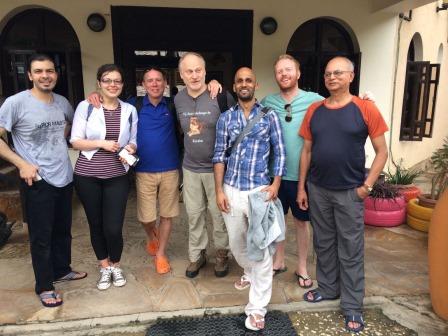
The hospital was located in the small town of Korogwe some 300km (6-8 hours) northwest from Dar Es Salaam (the place of peace). Korogwe is primarily a transport junction and of relative anonymity despite sitting on the outskirts of the beautiful densely forested Usambara mountains.
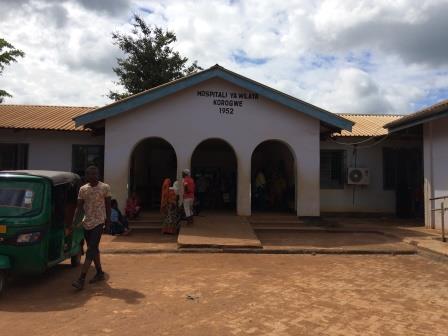
Our journey took us from the UK to Dar Es Salaam were we stayed overnight before making the 8 hour mini-bus journey to Korogwe. On our arrival Sister Avelina Temba (Nun and chief surgeon) and her team were present to welcome us. During our introductions the importance of missions like ours couldn’t have been clearer. We were told that on average there were 10 deaths per years from complications related to hernias and that of the ones that were repaired there was a 60% recurrence rate. We would later witness the importance of the mission first hand when we performed an emergency femoral hernia repair on a young lady who was acutely unwell for days with a strangulated hernia and small bowel obstruction.
The hospital
The hospital itself was a blast from the past, a 1950s build consisting of approximately 100 beds divided into traditional nightingale wards.
Our journey took us from the UK to Dar Es Salaam were we stayed overnight before making the 8 hour mini-bus journey to Korogwe. On our arrival Sister Avelina Temba (Nun and chief surgeon) and her team were present to welcome us. During our introductions the importance of missions like ours couldn’t have been clearer. We were told that on average there were 10 deaths per years from complications related to hernias and that of the ones that were repaired there was a 60% recurrence rate. We would later witness the importance of the mission first hand when we performed an emergency femoral hernia repair on a young lady who was acutely unwell for days with a strangulated hernia and small bowel obstruction.
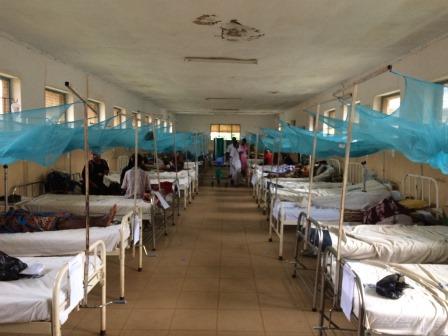
There were three operating theatres. Two were large, with one just about suitable for basic general anaesthesia and the other for spinal anaesthesia. Both rooms had state of the art, donated anaesthetic machines but they were lacking readily available key components necessary for safe anaesthesia (more on this later). Both rooms had descent theatre lights and semi-functional air conditioning. The third theatre was a tight squeeze and can only be described as a small bedroom with a theatre table and a standing theatre light. Non-the-less it worked well as a theatre for performing smaller hernia repairs under local anaesthesia.
The surgical sets often had an array of instruments, which were a little worn but were usually fine to use. To help with future missions we donated 200 instruments most of which were brand new. We were very fortunate to have three fully functioning diathermy machines.
Equally as important as the facilities and equipment was the full compliment of Korogwe staff who supported us and were essential to the smooth running of the mission.
Day to day
Our days would begin at 7.30am after a hearty breakfast with a short ride from our accommodation to the hospital. The pre-operative patients were assessed and listed for their operation by us at the end of the previous operating day.
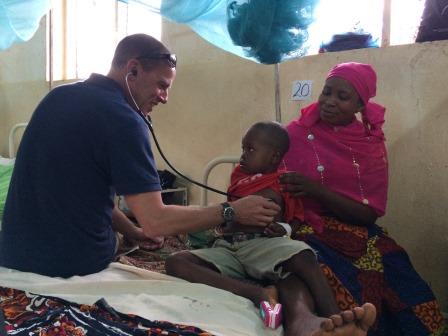
The local doctors clerked, bled (viral screen), consented, marked and canulated them so that they were ready to go by the morning. Before we started operating we would review our post-operative patients from the previous day to ensure that they were well. We operated in all three theatres simultaneously and so had a continuous flow of patients, which was facilitated by the theatre staff. Lunch was provided by the hospital and was usually a mixture of ndizi-nyama (plantains with meat) or samaki (fish) with ugali (maize) and vegetables. The afternoon theatre lists would run until about 6pm after which we would see the pre-operative patients for the next day.
Operative record
Over 5 operative days we performed 64 procedures on 50 patients. The most common procedure were inguinal hernias repairs of which there were 32. Five of these hernias were the typical large inguino-scrotal hernias of the developing world and 2 were recurrent hernia repairs. Other procedures included 17 umbilical hernia repairs, 10 hydrocelectomies, 2 epigastric hernia, 1 cord spermatocele, 1 large incisional hernia repair and 1 emergency femoral hernia repair for a strangulated hernia. We also provided anaesthetic support for a category III C-section, which was undertaken by Sister Avelina.
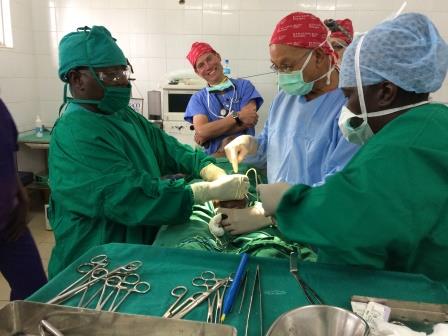
With the expertise of our consultant surgeon Biku and consultant anaesthetist Patrick we were able to safely offer paediatric surgery to 14 children, the youngest of which was 18 months old. We utilised all three theatres and operated on 16 patients under general anaesthesia, 19 patients under spinal anaesthesia and 15 patients under local anaesthetic.
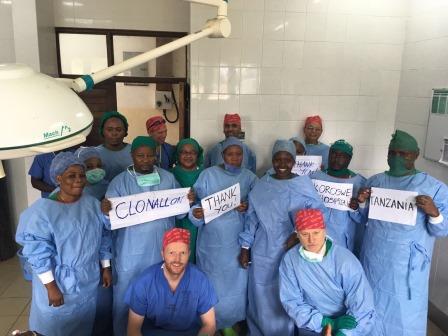
One of our most challenging cases was our very first. We performed a large incisional hernia repair in a 65-year-old gentleman under spinal anaesthesia, which later had to be converted to a general anaesthetic with ketamine. He made a slow but steady recovery and was discharged 5 days later. To avoid an inevitable seroma and because we didn’t have a redivac (negative pressure) drain, our surgical SHO Christina came up with a novel negative pressure drainage system using a 50ml and 10ml syringe and some tape.
The first two days were highly productive having undertaken 33 surgical procedures. Unfortunately heavy monsoon rains and floods made it difficult for patient to get to the hospital and as such our productively slowed. We did not get disheartened as this gave us more time provide training to the local surgeons in the technique of mesh repair for inguinal hernias.
Practical anaesthesia in a resource limited setting
Patrick and Jonny our anaesthetist performed valiantly with such limited resources. They had to adapt their normal practice and improvise when needed. To keep things simple and safe the kids received halothane to breathe and our surgeon Biku gave them local anaesthetic as he cut. The vaporiser can easily be used to provide halothane anaesthesia without too much fuss. Most of the adults received spinal anaesthesia using a single shot of bupivacaine. There were limited drugs, syringes, needles etc. Fortunately the anaesthetist brought 100 doses of bupivacaine and some emergency medications – worth their weight in gold.
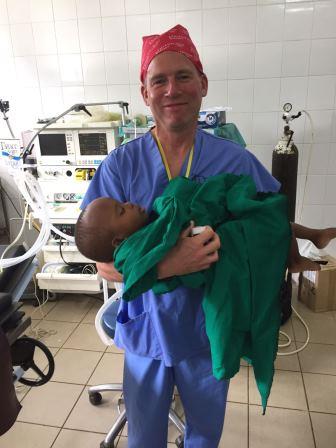
The anaesthetic machines in theatre were only functional for monitoring and even then there was a lack of ECG adhesive pads. This was overcome by the application of some lubricating gel and tape to the bare lead electrode. The anaesthetic machines were missing key components. Crucially and somewhat frustratingly the plug from some of the machines did not fit the three-pin socket. All that we needed was a normal kettle lead fitted with a three-pin plug to fire up the world class monitoring system. In addition, CO2 absorbers were missing, which would have provided a readily usable ventilator and circle system.
One of the biggest problems was the limited provision of pressurised oxygen. Only a single large cylinder, which lasted about 10 hours was available. Replacing it wasn’t easy but Avelina’s team did well to source a small cylinder, which again is now unfortunately in the red zone. In addition there was only one regulator without which oxygen cannot be delivered. The lack of pressurised oxygen is probably the biggest issue to address as it is essential for keeping patients safe. It would be important before any future mission to request that Sr Avelina looks at finding a way to have one large cylinder being topped up, while at least two full ones are physically present in the hospital.
Shopping list for future missions
Visiting surgeons and anaesthetists need to consider how best to equip themselves prior to leaving. One important factor to mention is that patients who are planned for a hernia repair have to pay a small sum of money. This buys them a physical operation but not always the materials and drugs that come with it for example antibiotics, anaesthetic, syringes, needles, sutures etc. As a result we brought most of the materials ourselves.
With three theatres running at full capacity there is potential to undertake 90-100 procedures. We have provided a brief list of materials based on our recent mission.
Surgical materials needed:
· Gowns
o Korogwe do have their own re-usable gowns but we brought in excess of 200 disposable gowns ourselves. They should be able to accommodate for future missions without the need to extra gowns.
· Gloves
o Will need plenty for the team and korogwe staff
· Face masks and theatre caps
· Mesh
o Sterilised and of the mosquito brand
· Sutures
o Lots of 2/0 vicryl, 2/0 prolene, 3/0 monocryl
· Local anaesthetic
o They only had plain 1% lidocaine and adrenaline was available separately.
o Safer to take lidocaine and bupivacaine pre-mixed with adrenaline.
· Diathermy plates
o They have a metal plate which they re-use
o Recommend disposable plates, which we reused.
· Diathermy pencil tips
· Drugs – Antibiotics, analgesia
· Dressings, needles, syringes
Anaesthetics materials needed
· Oxygen regulators
o Only one available at present
· CO2 absorber and breathing circuits
· Laryngoscope
o I would suggest that one is not left there as they are very easy to misplace
· Intubation/airway equipment
· Paediatric masks, airways and LMAs
· IV cannulas
· Nitrile gloves, tape and cleaning solution
· Anaesthetic drugs
General
· Malaria prophylaxis and repellent is essential especially for a mission in May (very wet season).
· US dollars as well as Shillings, which can be bought from the airport or from banks close to the hospital.
· Tourist visa ($50 from the airport) – it’s a lot cheaper than a business visa.
Cost of the mission and accommodation
Our flights from various parts of the UK to Dar Es Salaam cost approximately £350 when we booked a couple of months in advance. Most of us landed late on the Saturday and spent the night at the Best Western Plus Colosseum Hotel in Dar Es Salaam (£100). Early on Sunday morning our mini-bus (£280 to total), which was arranged through Sr Avelina took us to the hospital and later to our accommodation – the White Parrot.
The White Parrot was basic but served all of our needs. Bed and breakfast was a modest £20/night. They had their own restaurant for dinner, which was also great place for a nice cold Tusker beer or Fanta after a long sweaty day at work.
Many people to thank
Above all, the biggest thank you is to Hernia International for opening doors for teams like ours to provide a service for the people of Korogwe.
Also, we are hugely thankful for the efforts of our team leader Alex, who behind the scenes been carefully masterminding every aspect of the mission. Our team, most of whom had not worked with each other before were excellent. We all appear to have just clicked, mucked in, and battered on through the work with great efficiency, warmth and good humor.
Finally, the team in Korogwe led by Sister Avelina has been marvelous. From the red carpet treatment meeting the officials on day one, to the generosity, hard work and willingness to accommodate shown by the staff. It was a pleasure to work with them through Hernia International and we look forward to future missions.
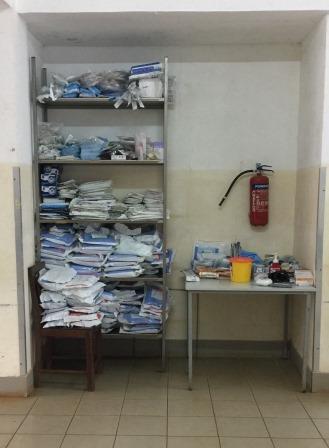
Vernon Sivarajah
